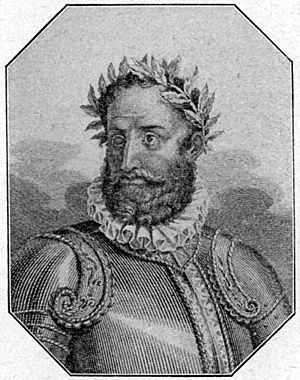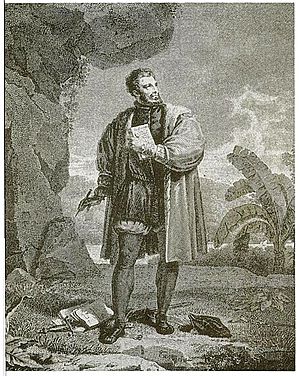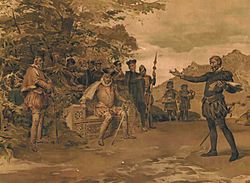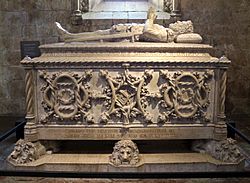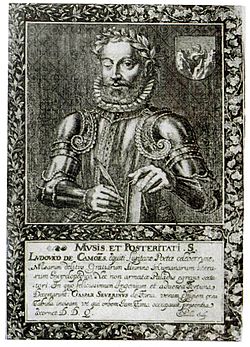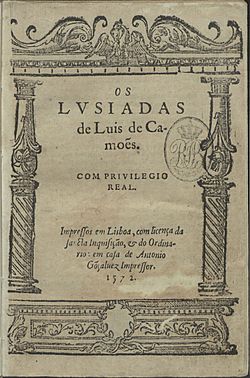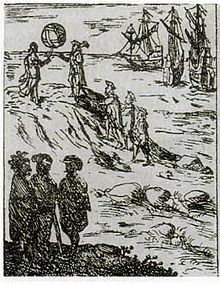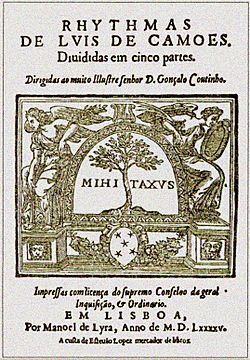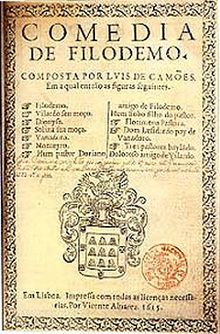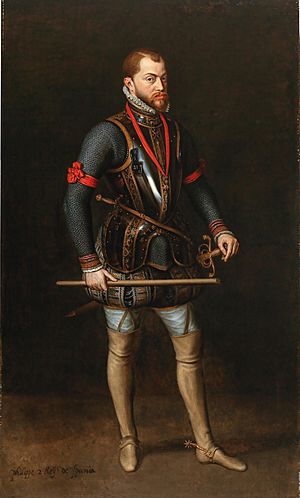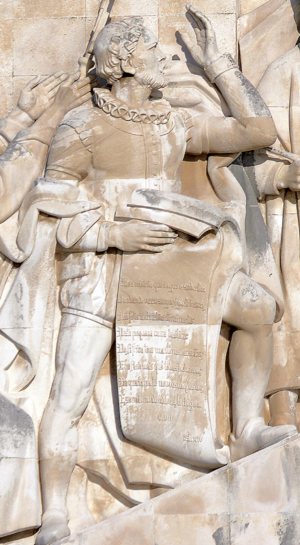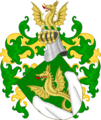Luís de Camões facts for kids
Luís Vaz de Camões (born around 1524 or 1525 – died June 10, 1580) is known as Portugal's greatest poet. Many people compare his amazing writing skills to famous poets like William Shakespeare and Homer. He wrote a lot of poems and plays, but he is most famous for his epic poem, Os Lusíadas (which means The Lusiads). This poem is so important that the Portuguese language is sometimes called the "language of Camões."
The day he died, June 10, is celebrated as Portugal Day, the country's national holiday.
Quick facts for kids
Luís de Camões
|
|
|---|---|
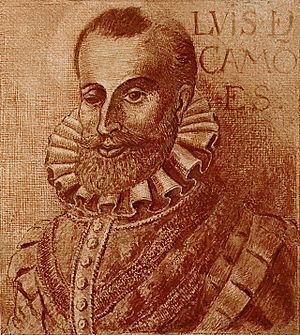
Portrait c. 1577
|
|
| Born | Luís Vaz de Camões c. 1524–1525 Lisboa(?), Coimbra(?), Constância(?) or Alenquer(?), Kingdom of Portugal |
| Died | 10 June 1580 (aged 55–56) Lisbon, Kingdom of Portugal |
| Occupation | Poet |
| Alma mater | University of Coimbra |
| Period | Portuguese Renaissance |
| Genre | Epic poetry |
| Literary movement | Classicism |
| Notable works | The Lusiads |
| Relatives | Camões Family |
Life of Luís de Camões
Early Years and Education
Not everything we know about Luís de Camões' life is certain, and some stories might just be legends. However, we do have some important dates. His family, the Camões family, came from Galicia, a region in Spain. His ancestors were important figures, including a poet and warrior.
Luís Vaz de Camões was likely born in Lisbon in 1524. When he was three, his family moved to Coimbra because of the plague. Other cities also claim to be his birthplace, but Lisbon is the most accepted.
Not much is known about his childhood. Around age twelve or thirteen, his uncle Bento, who was a priest, probably helped him get an education. Luís was said to be a curious student, interested in history, maps, and classic books. Even though his name isn't in the records of the University of Coimbra, his writings show he had a very good education. He might have studied at the monastery college.
Around age twenty, he likely moved back to Lisbon. Even though his family wasn't rich, they were noble, which allowed him to be part of the royal court of John III of Portugal. This is where he started his career as a poet.
Adventures and Challenges
Camões was known for living a free-spirited life. He often visited taverns and got into arguments. One time, in 1553, he had an argument with a royal palace employee and wounded him with a sword. He was sent to prison but was later released by the king's order. The king's pardon said he was "a young man and poor and he is going to serve in India this year."
So, Camões set sail for India on March 24, 1553. His last words before leaving, he wrote, were like those of a famous Roman general: "Ungrateful fatherland, you will not possess my bones."
Journey to the East
Camões traveled on a ship called the São Bento. He sailed through the same areas as Vasco da Gama, faced a big storm near the Cape of Good Hope, and arrived in Goa, India, in 1554. He joined the army and fought in an expedition against a local king. In 1555, he also went on a mission to fight in the Red Sea.
It's believed that he started writing Os Lusíadas during this time. When he returned to Goa in 1556, he got into trouble again, possibly for criticizing corruption or for debts. He might have been in prison until 1561.
Later, he was appointed to a position in Macau in 1562, serving there until 1564 or 1565. Macau was a small trading post back then. Legend says he wrote part of Os Lusíadas in a cave there, which is now named after him.
On his way back to Goa, his ship was wrecked near the Mekong River. The story says he managed to save only himself and the manuscript of Os Lusíadas. This event deeply affected his writing.
After the shipwreck, he was taken to Malacca. He faced more legal issues there. The exact date of his return to Goa is not known, but he might have spent more time in prison. Despite his troubles, he continued to write poetry and serve as a soldier, always showing bravery.
Life in the East was challenging. He lived simply, often sharing a house with friends. These friends were often educated people, and they would discuss literature and ideas. They also enjoyed writing satire, which was risky but fun. Camões and his friends were part of a movement that valued both military success and the fame that came from culture and learning.
Return to Portugal and Final Years
In December 1567, Camões began his journey back to Portugal. He stopped in Mozambique, where he waited for a ship to Lisbon. His friend, the historian Diogo do Couto, found him there two years later, very poor and relying on friends for food. His friends helped him get clothes and food. While in Mozambique, he finished Os Lusíadas and was also working on another book of poetry, which was unfortunately stolen.
When he tried to leave, he was stopped because he owed money to the governor. His friends collected the money, and Camões was finally released. He arrived in Cascais, Portugal, on April 7, 1570.
After all his adventures, he finally completed Os Lusíadas. He presented it to King Sebastian of Portugal, who was still a teenager. The king ordered the work to be published in 1572 and gave Camões a small pension for his service in India. The pension was not huge, but it was considered honorable for a soldier at the time. However, it was often paid late, causing Camões financial difficulties.
Camões spent his last years in Lisbon, reportedly in poverty. He died on June 10, 1580, possibly from the Bubonic plague, after Portugal suffered a major defeat in the Battle of Alcácer Quibir. He was buried in a simple grave. Later, after the 1755 Lisbon earthquake destroyed much of the city, attempts to find his remains were unsuccessful. The bones placed in his tomb at the Jerónimos Monastery in 1880 are likely not his.
Appearance and Personality
People who knew Camões described him as a man of average height with reddish-blond hair. He was blind in his right eye, which he lost in a naval battle. He was good at physical activities and had a strong personality, often getting into fights. He was known as a brave and loyal soldier. In his free time, he was a good friend, cheerful, and witty, unless he was struggling with life's difficulties. He was also very aware of his own worth as a man, a soldier, and a poet.
Many stories exist about the women he loved, but it's hard to know which ones are true. Camões himself hinted that many different people inspired him. The names of specific women often appeared in later stories about him, not in his earliest biographies.
The most reliable image we have of Camões is a portrait painted between 1573 and 1575, which is shown at the beginning of this article. It's a copy of an original that was lost in a fire. Another small portrait, painted in India in 1581, was said to look very much like him.
Over the centuries, Camões has been honored many times in art, including paintings, sculptures, and monuments. The large Camões Monument in Lisbon, built in 1867, is a central place for public ceremonies. He has also been featured in music, on coins, stamps, and as a character in books and plays. The film Camões was the first Portuguese film to be shown at the Cannes Film Festival in 1946. Even a crater on the planet Mercury and an asteroid are named after him!
Camões' Works
Historical Background
Camões lived during the end of the European Renaissance, a time of huge changes. This period marked the end of the Middle Ages and the start of the Modern Age. It was called the "renaissance" because people rediscovered and valued the ideas and art of Classical Antiquity (ancient Greece and Rome). This led to a focus on Humanism, which emphasized the dignity of humans and placed them at the center of the universe. Reason and science became very important.
During this time, many scientific tools were invented, and new discoveries were made in physics, math, medicine, and astronomy. The world map itself changed with the great voyages. People were optimistic about human progress. The Renaissance tried to blend ancient ideas with Christianity and influences from other cultures. It was also a time when strong nations began to form, trade grew, and cities expanded.
By the 16th century, when Camões lived, the Renaissance ideas were spreading across Europe. However, there were also many wars and religious conflicts, like the Protestant Reformation. The Catholic Church responded with the Counter-Reformation, bringing back the Inquisition and censorship. This created a tense atmosphere, which influenced art. Even though artists were inspired by classic styles, their work often showed restlessness and conflict, reflecting the challenges of the century. This style is called Mannerism.
Portugal, since the 15th century, had become a powerful naval and trading nation. There was great excitement for maritime conquests. People felt proud of their country's achievements in exploring the oceans and defeating enemies. There was a desire for someone to write an epic poem celebrating these feats. Camões filled this need, even as Portugal was heading towards a political crisis and would soon lose its independence to Spain after his death.
Overview of His Writings
Camões' writings fall into three main types: lyrical (poems about feelings), epic (long poems about heroes), and theatrical (plays). His lyrical poems were immediately popular. His epic work, Os Lusíadas, is a powerful celebration of Portugal's achievements, including military victories and overcoming nature's challenges, often using classic stories and symbols.
His experiences as a soldier and sailor greatly influenced his writing. The difficulties he faced, the pain of being away from home, and his longing for Portugal deeply affected him and his work. His best poems show genuine suffering and honesty, which is why they are so highly regarded.
Camões was very knowledgeable. He knew Latin and Spanish well. He also had a deep understanding of Classical mythology, European history, and classic literature from authors like Homer and Virgil, from whom he borrowed ideas and styles. He also knew works by ancient scientists and historians. Among modern writers, he was familiar with Italian poets like Petrarch and Ludovico Ariosto, and Spanish literature.
Many experts describe Camões' style as Mannerism, which came after the pure Renaissance style. This is because his work often shows a sense of anxiety, drama, and conflict, rather than the calm balance of earlier Renaissance art. He used contrasts, strong emotions, and complex language. He combined ideas from humanism with older ideas of chivalry and crusades. He also blended Catholic faith with ancient mythology in his epic poem.
Os Lusíadas
Os Lusíadas is considered Portugal's most important epic poem. Its title comes from "Lusitania," the ancient Roman name for Portugal, showing its national pride. It's one of the most significant epic poems of the modern age. The poem tells the story of Vasco da Gama and other Portuguese heroes who sailed around the Cape of Good Hope to open a new sea route to India. It's a humanist epic because it combines pagan myths with Christian beliefs, and shows mixed feelings about war and empire, and the balance between adventure and a desire for peace.
The poem has ten cantos (sections), with 1,102 stanzas and 8,816 lines. It uses a special rhyme scheme called ottava rima. After an introduction and a dedication to King Sebastian, the story begins, blending myths and historical facts.
As Vasco da Gama sails along the coast of Africa, the ancient gods watch and discuss his journey. Venus protects the expedition, while Bacchus tries to stop it. The fleet rests in Malindi, where Vasco da Gama tells the local king the entire history of Portugal, from its beginnings to their current voyage.
Cantos III, IV, and V contain some of the most famous parts of the epic:
- The sad story of Inês de Castro, a symbol of love and death.
- The Battle of Aljubarrota, a key Portuguese victory.
- The vision of King Manuel I.
- The description of St. Elmo's fire (a weather phenomenon).
- The story of the giant Adamastor, who represents the dangers of the sea.
Back on the ship, Camões tells the story of the Twelve of England. Bacchus then calls on the sea gods to destroy the Portuguese fleet, but Venus intervenes, and the ships reach Calicut, India. On the return trip, the sailors enjoy an island created for them by Venus. One of the nymphs sings about Portugal's glorious future, and the scene ends with Tethys describing the universe to Vasco da Gama. Then, the journey home continues.
In Os Lusíadas, Camões skillfully combines his knowledge of classical literature with his real-life experiences. He describes battles, natural forces, and human interactions with great detail and beauty. The poem also serves as a serious warning for Christian kings to stop fighting among themselves and unite against the expansion of Muslim empires.
The structure of the poem is very interesting. Some scholars believe Camões used the golden section to organize the work, placing important events at specific points. For example, applying the golden section to the whole poem points to the moment the Portuguese arrive in India.
It's believed that Camões started writing Os Lusíadas as early as 1554. He was still working on it in Mozambique in 1568-1569, and it was finally published in Lisbon in 1572. The success of the poem led to a second edition in the same year.
Rimas (Rhymes)
Camões' lyrical poems were scattered in different manuscripts and were collected and published after his death in 1595 under the title Rimas (Rhymes). Over time, as his epic poem became more famous, these lyrical poems also gained appreciation. The collection includes various types of poems, such as sonnets, odes, and songs.
His lyrical poetry drew from many sources. His sonnets often followed the Italian style of Petrarch. His odes showed influences from medieval troubadour poetry and classical poems. He also used older Portuguese poetic forms.
Unfortunately, many poems were wrongly included in later editions of Rimas, and some original texts were changed. This made it difficult for scholars to study his work accurately. However, enough authentic material remains to confirm his place as Portugal's best lyric poet and its greatest Renaissance poet.
Comedies
Camões also wrote for the stage, combining national themes with classical inspiration, similar to Os Lusíadas. He wrote three comedies: El-Rei Seleuco, Filodemo, and Anfitriões. However, whether he truly wrote El-Rei Seleuco is debated.
Anfitriões, published in 1587, is an adaptation of an ancient Roman play. It highlights the funny side of the Amphitryon myth, showing how love can even affect gods. This play uses two languages, with the slave character speaking Castilian (Spanish) to show his lower social status, adding to the humor.
Filodemo, written in India, is a comedy about a servant named Filodemo who loves the daughter of the nobleman he serves. This play is well-regarded for its insights into human experiences and psychology. Camões saw comedies as less important, but he was good at making the characters and plot funny. He showed a new direction for Portuguese comedy, but unfortunately, later playwrights didn't follow his lead.
Camões' Fame Beyond Portugal
Even though Camões is one of the greatest epic poets, he is not as well-known outside Portugal as some others. However, many famous non-Portuguese writers and thinkers have praised him. For example, Torquato Tasso, a famous Italian poet, said Camões was the only rival he feared. Miguel de Cervantes, the author of Don Quixote, called Camões the "singer of Western civilization." He also influenced poets like John Milton in England. Johann Wolfgang von Goethe, a great German writer, recognized his importance.
Camões' fame began to spread in Spain, where he had many admirers. Two translations of Os Lusíadas appeared in 1580, the year he died, ordered by Philip II of Spain, who was also the king of Portugal at the time. Philip II even gave Camões the honorary title of "Prince of the Poets of Spain." This helped to connect Camões and Portuguese culture with the Spanish crown.
Soon, his fame reached Italy. By 1658, Os Lusíadas had been translated twice into Italian. It later became an important example in Italian Romanticism. In England, Os Lusíadas arrived in 1655, but became more famous after a poetic version was published in 1776. Many more English translations followed.
In France, a translation of the epic appeared in the early 18th century. While Voltaire criticized some parts of the work, he also admired its new ideas, which helped make it popular. Montesquieu said that Camões' poem had the charm of Homer's Odyssey and the grandeur of Virgil's Aeneid. Between 1735 and 1874, over twenty French translations of the book were published. Os Lusíadas was also translated into Dutch and other languages, spreading Camões' influence across Europe.
In Culture
- Camões is the subject of the first romantic painting by a Portuguese artist, A Morte de Camões (1825), by Domingos Sequeira, which is now lost.
- He is a character in Gaetano Donizetti's opera Dom Sébastien, Roi de Portugal.
- Camões plays a big role in the book Het verboden rijk (The Forbidden Empire) by the Dutch writer J. Slauerhoff.
- There is a museum dedicated to Camões in Macau, called the Museu Luís de Camões.
- In Goa, India, the Archeological Museum at Old Goa has a tall bronze statue of Luís de Camões. Another monument to Camões in Goa is a tall pillar in the Jardim de Garcia da Orta Garden.
- A seamount (an underwater mountain) in the Indian Ocean is named after him.
- The Institute Menezes Braganza in Panaji, Goa, has beautiful Azulejos (painted ceramic tiles) on its walls that show scenes from Os Lusíadas.
- A puppet play about Camões, called Camoes, the One-Eyed Poet of Portugal, premiered in Toronto in 2006.
Images for kids
See also
 In Spanish: Luís de Camões para niños
In Spanish: Luís de Camões para niños


